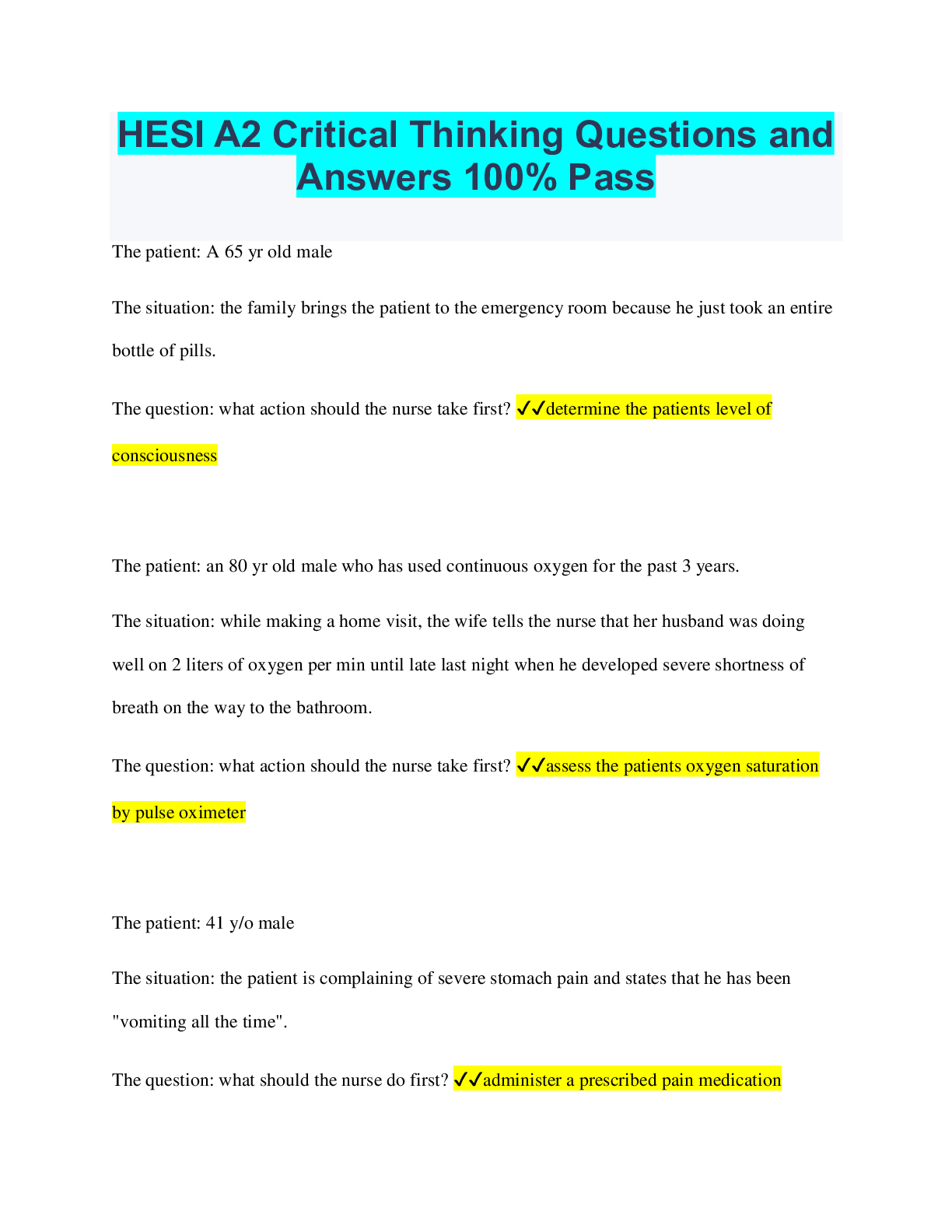Biology > QUESTIONS & ANSWERS > UTSA BIO 1053 Exam 2 study Guide (All)
UTSA BIO 1053 Exam 2 study Guide
Document Content and Description Below
UTSA BIO 1053 Exam 2 study Guide Chemical energy from ATP is easily converted to other energy forms and can be used to drive cellular processes (t/f) - ✔✔true Organic molecules contain carbon (... t/f) - ✔✔true ATP releases energy when it loses a..... - ✔✔phosphate group A microorganism that needs many ready-made organic compounds to survive is called a __________________ organism. - ✔✔fastidious Both pyruvate decarboxylation and the citric acid cycle produce CO2 as a by-product. (t/f) - ✔✔true In aerobic respiration, which molecule serves as the Final electron acceptor in the Electron transport system? - ✔✔O2 Enzymes drive reactions in cell by lowering the . - ✔✔Activation energy While the Citric acid cycle does produce some ATP, it largely functions to oxidize NAD+ to NADH for oxidative phosphorylation. (t/f) - ✔✔false The light-dependent reactions are where light is used to initiate an electron transport chain and ATP synthase. (in photosynthetic organisms). (t/f) - ✔✔true Photosystem I is where the light photons are received by the photoreactive pigments like chlorophyll. (t/f) - ✔✔false Proper specimen collection, transportation, culturing, and analysis are all critical aspects of diagnosing a microbial pathogen. (t/f) - ✔✔true Since cell division in Prokaryotes is asexual, there is no opportunity for genetic recombination. (t/f) - ✔✔false Photosynthesis occurs in chloroplasts in eukaryotes and in the thylakoids of prokaryotes. (t/f) - ✔✔true The Calvin cycle must rotate 6 times (or six consecutive cycles) to form one molecule of glucose. (t/f) - ✔✔true Isolated colonies represent pure cultures because they are derived from a single cell or a colony forming unit. (t/f) - ✔✔true Chains of 3-6 carbons in length, with OH groups. Can link. - ✔✔Mono/di/poly-saccharides long chain hydrocarbons, hydrophobic, saturated or unsaturated - ✔✔Fatty acids Alpha carbon with amine and carbonyl groups plus a functional group, "R group." Links to build proteins. - ✔✔Amino Acids Nitrogenous bases that pair, and are also bound to a sugar phosphate backbone. - ✔✔DNA/RNA What bacterial plating method would you use to isolate an organism from a concentrated mixed culture? - ✔✔Four quadrant streak Which cellular process produces ethanol or lactic acid as a byproduct? - ✔✔fermentation If a culture starts with 20 cells, how many cells will be present after 4 generations with no cell death? - ✔✔320 Oxidative phosphorylation to produce ATP relies on the enzyme ATP reductase. (t/f) - ✔✔false Growth media can either be selective or differential but not both. (t/f) - ✔✔false ATP synthase is an enzyme that relies on chemiosmosis of electrons across the membrane with the concentration gradient. (t/f) - ✔✔false Obligate anaerobe - ✔✔ Obligate aerobe - ✔✔ Facultative anaerobe - ✔✔ Carbon is an important and unique atom in that it has valence electrons, which can make covalent bonds with hydrogen, oxygen, other carbons etc....to make large organic polymers. - ✔✔4 Which choice explains why a stationary phase follows an exponential phase of growth, when bacteria is grown in culture? - ✔✔the cells run out of nutrients the cells run out of space the cells produce toxic waste compounds that can accumulate ALL OF THE ABOVE The Miller-Urey experiment offered a potential answer for how life (organic biological compounds) on earth began from inorganic compounds. The organic compounds they found in their "primordial soup" replication were DNA/RNA. (t/f) - ✔✔false Which of the below statements is the correct definition of "generation time" - ✔✔time it takes for a cell to grow and divide into 2 new cells Based on the medium recipe given below, identify whether the given medium is defined or undefined. Ingredients: Sucrose 10 grams, Cysteine 5 grams, Magnesium chloride 5 grams, Agar 5 grams, Sheep Blood 50 ml, Distilled water 1000 ml - ✔✔Undefined In one of the most amazing feats of nature, the Hill reaction, involves the splitting of , which provides electrons for photosystem II. - ✔✔Water (H2O) Select all that apply in regards to Glycolysis. - ✔✔It requires oxygen It occurs in the cytoplasm It produces a net of 2 ATP It continuously reduces NAD+ to NADH Gets energy from the sun and uses inorganic carbon - ✔✔Photoautotroph Gets energy from breaking the bonds in organic molecules like sugar. - ✔✔Chemoheterotrophs Prefers low pH environments - ✔✔Acidophiles [Show More]
Last updated: 2 years ago
Preview 1 out of 9 pages

Buy this document to get the full access instantly
Instant Download Access after purchase
Buy NowInstant download
We Accept:

Reviews( 0 )
$10.00
Can't find what you want? Try our AI powered Search
Document information
Connected school, study & course
About the document
Uploaded On
Dec 15, 2022
Number of pages
9
Written in
Additional information
This document has been written for:
Uploaded
Dec 15, 2022
Downloads
0
Views
84














